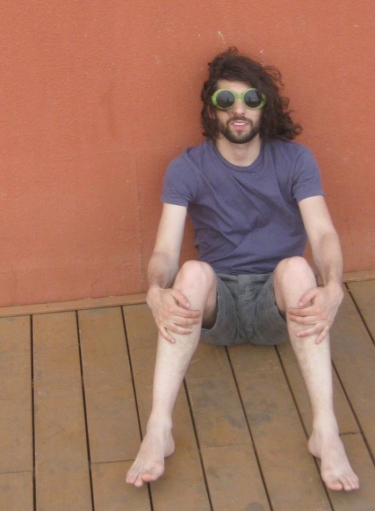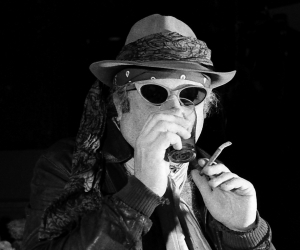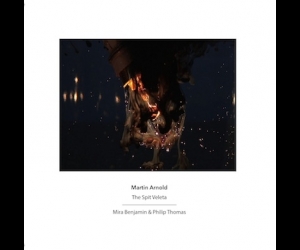
“I’ve always been interested in perception and apperception,” writes Montreal-based composer Adam Basanta in a recent e-mail correspondence. “This has led me, as a musician and composer, to centre my work on listening as a perceptual and psychological experience.” The cerebral nature of this statement is in direct contradiction to the playful Web image of him smiling while sitting on a playground swing, and to his music, which is by no means forbiddingly cerebral or clinical. In fact, his fascination with the perceptual facet of listening, even when it means that he sometimes keeps abreast of neuroscientific research—which in turn inspires his ideas—is what grounds his music in a certain tangibility.
Basanta’s recent series of installations serve to demonstrate ways in which his perceptual experimentation manifests itself. In object/ field (2011) and Diagonal (For Eastern Bloc) (2011) Basanta explores the mutual influences between auditory and visual modalities. In a darkened room, thin crystalline tones flirt with the upper range of human hearing, as cracked purrs and limpid chiming flecks move about in the space. The visual component maps an analogous terrain juxtaposing intermittent incandescent flashes and round lambent glows, sometimes highlighting sonic events, other times providing bold or muted visual counterpoint. These audio and visual elements operate at sensory extremes and illuminate the space (figuratively and literally) in a manner that actually transforms the audience’s perception of it.
The piece object/ field tends to dwell faintly in the outer edge of visual and auditory quietude, offering events that can be so minute that one may even mistake them for hallucinations. Diagonal’s cycle, on the other hand, flows from delicate to more saturated and loud, drawing audiences through different modes of attention and perception.
“Extremes are something I am very interested in at the moment,” Basanta writes. “I find that they are very effective ways of generating affect in the listener; an extremely loud sound requires extreme effort from the performer and may jar the listener; an extremely quiet sound requires extreme concentration and attention from both performer and listener. Both cases involve a mental or psychological ‘threshold shift’ on the part of the listener, as they adjust to a very aggressive or loud sound, or a very gentle, quiet sound. I like to think that I am attempting to compose these mental shifts of the listener–spectator, to make them attend to these shifts, as well as to the physical and mental effort they have to make in order to cope with a loud sound or a saturation of light, or on the other hand, a very quiet sound or borderline imperceptible visual material.”
feelings I’m too tired for (2011), the recent winner of the SOCAN Foundation’s Pierre Mercure Award in their young composers competition, explores different types of contrast. Beginning with a furious, gory sonic eruption, before slipping into a peculiar wheezy mist, the work pits a solo bass clarinet against a fixed electroacoustic track. The piece charts a vast spectrum from ferocious and brazen to feeble and flaccid. The score variously invites the performer to employ a “nasty timbre,” to be “foul, offensive;” but then conversely instructs the performer to play as though “suddenly self-conscious,” and even “accepting weakness.” The broad palette was designed to paint a sense of physical exertion and exhaustion. Basanta even encourages a degree of skewed theatricality from the performer to bolster this aspect, requesting grimaces of exaggerated physical duress in his performance notes.
The work draws its physicality from an image relayed to him by a friend, who had attended an Anthony Braxton performance/installation. There, saxophonist Steve Lehman, as though out of frustration, emitted a squall of aggressive and belligerent (yet strangely futile) racket while facing into a wall. The second-hand image made a strong impression on Basanta, who opted to furnish a metaphorical reply from the wall by way of the electroacoustic part, which was derived entirely from processed bass-clarinet sounds.
Basanta’s aims render his sensory curiousity contagious. And the young composer is certainly not without support, garnering numerous awards in the past three years, as well as various concert and festival appearances worldwide. Certainly the richness and dynamism of colour in his pieces stirs questions.
“The idea is to coax the audience into feeling their own ‘liveness,’ their own participation in constructing or co-performing the work with you in a unique, non-repeatable [event]. And this can occur through live electroacoustic performance, but also through fixed-media works, installations, and instrumental music.”
Audio: feelings i’m too tired for (2011). Composed by Adam Basanta. Performed by Krista Martynes, bass clarinet and electronics. Image: Adam Basanta. Image by: Charles Quevillon.


